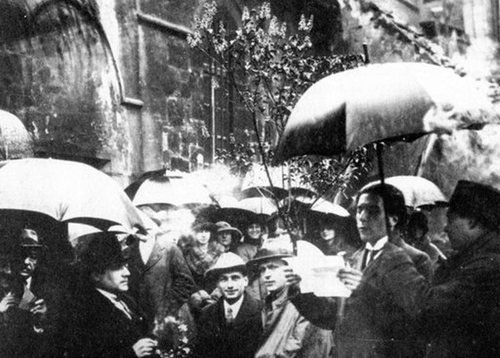
One of the pleasures of researching the history of the simple human act of walking is that, just like a good walk, it takes you in unexpected directions. Recently, while considering the prehistory of walking as an artistic activity, I came across a Dada event, held in Paris just over a century ago, that stands as (probably) the first example of a ‘walking performance’ or ‘walking as art’.
The Dada movement, led by Tristan Tzara and others, began in the Cabaret Voltaire, Zurich, in neutral Switzerland, during the First World War. It took to extremes the revolutionary tendencies in art, especially in Paris, in the years before the war, by mocking to absurdity and reducing to nonsense almost everything held dear by artists and art lovers, and indeed society as a whole, up to that time. Outrage and meaningless were the key Dada ideals.

A printed flyer inviting people to the first event in a projected series of ‘excursions and visits’. The first of these was to be a trip on Thursday 14 April 1921 to the Paris church of St Julien le Pauvre. Under the heading ‘Dada excursions and visits’, the flyer explains:
On their way through Paris the Dadaists, wishing to correct the ineptitude of unreliable guides and cicerones, have decided to undertake a series of visits to selected places, especially those that don’t really have a reason to exist. It’s wrong that we insist on the picturesque (Lycée Janson de Sailly), historical interest (Mont Blanc) and sentimental value (the Morgue). The game isn’t lost, but we have to act quickly. To take part in this first visit is to realise human progress, possible destruction, and the obligation to pursue our action, which you will want to encourage by every means.

Visitors are requested to assemble in the church garden at 3.00 in the afternoon. Scattered around the poster, at various angles and in various fonts, are encouraging slogans: ‘property is the luxury of the poor, be dirty’; ‘Dada: a new cult’; ‘you should cut your nose like your hair’; ‘wash your breasts like your gloves’; ‘thanks for the gun’; ‘and one more time, hello’; ‘distribution of silk stockings at 5.85’; ‘cutting lessons’; ‘foot races in the garden’; ‘the piano very kindly lent to us by the house of Gâvault.’ Future trips are announced: to the Louvre, the Parc des Buttes Chaumont, Gare St Lazare, Mont du Petit Cadena, the Canal de l’Ourcq. The poster is ‘signed’ by a long list of Dadaists, many of them now famous names: Gabrielle Buffet, Louis Aragon, [Hans] Arp, André Breton, Paul Eluard, Théodor Fraenkel, J. Hussar, Benjamin Péret, Francis Picabia, Georges Ribemont-Dessaignes, Jacques Rigaut, Philippe Soupault and Tristan Tzara.

Saint-Julien le Pauvre is a medieval church on the south side of the Seine, opposite Notre Dame. According to a newspaper notice, ‘there is, it seems, still something to discover in this garden otherwise beloved by tourists. This is not an anticlerical manifestation, as one might be tempted to believe, but rather a new interpretation of nature applied this time not to art but to life.’ Saint-Julien was an example of a non-tourist destination that offered a good target for the practice of anti-tourism, and the ‘marvelisation’ of a totally ordinary location. The ‘excursion’ included a number of improvisations. On their walk the participants read poetry, and a parody of a tour guide. At the church André Breton read a manifesto, including the words ‘is there a church of Saint-Julien-le-Pauvre? For our part, we do not know’. Georges Ribemont-Dessaignes, the ‘tour guide’, read articles chosen at random from the Larousse dictionary.
But the event, it was agreed, was not a success. The rain poured down. About fifty people took part. The ‘auction of abstractions, that might have been sensational.’ was cancelled. The promised band failed to turn up. Curious onlookers drifted away. At the end the organisers retreated from the rain to a café. Breton, who had fallen out with Tzara and other Dadaists and was already preparing for the next ‘ism’, wrote after the event that Dada had run its course and that its actions no longer had any impact. None of the later advertised excursions took place, and before long the Dadaists ceased to exist.

Maybe, though, in the long run, the rainy event of 14 April 1921 on the south bank was not a failure but a success. You could see it as the culmination of the Dada effort to undermine the established order, in this case not through outrage, but through its opposite: promoting the dampness, boredom and indifference that Dada had originally set out to destroy. Banality and meaninglessness had finally reached their apotheosis – not in the theatres and nightclubs where the Dadaists had previously operated, but in the ordinary streets, and on foot rather than on the stage. It is in the everyday, and in everyday actions like walking, that the marvellous can grow. For the Surrealists – many Dadaists joined their ranks in the later 1920s – walking, mundane though it was, offered a way towards wonder. The Paris Situationists of the 1960s, and many since, have agreed with them.

Leave a Reply to Andrew Green Cancel reply